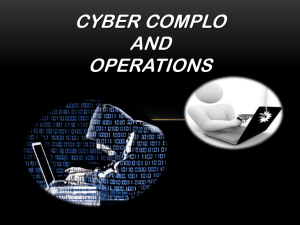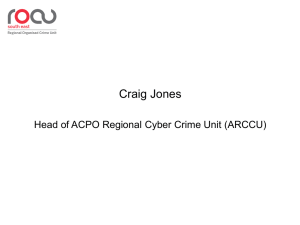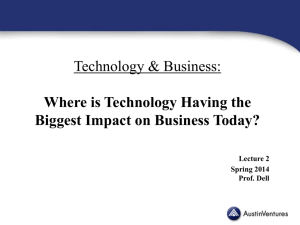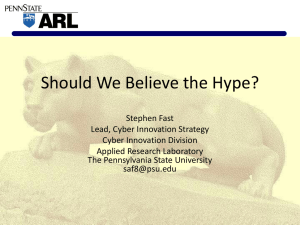Cyber Security Curriculum - King William County Public Schools
advertisement
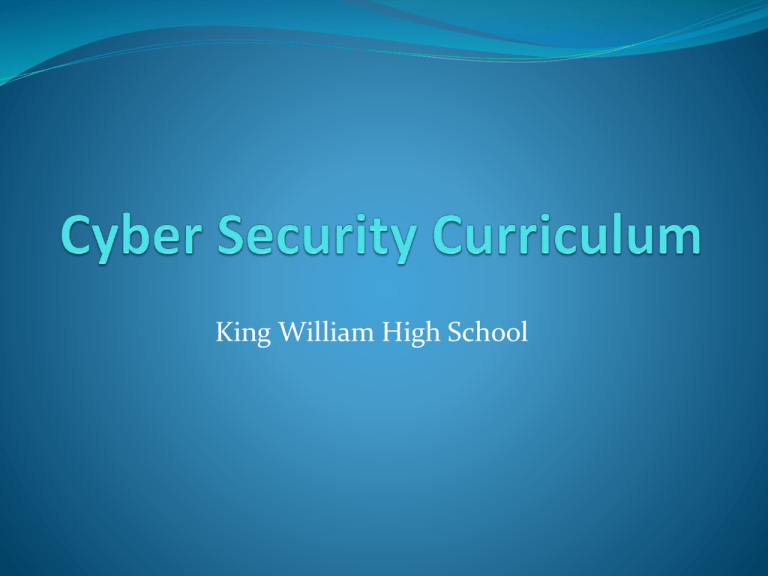
King William High School Cyber Security Curriculum 4 year high school curriculum Up to 5 technology certifications upon successful completion of each year, each with it’s own earning potential. Ultimate goal: Certified Ethical Computer Hacker Hired to protect network defenses for organizations by finding weaknesses in technology security systems. Tremendous demand for this position today. Currently, many jobs going to foreign nationals because of lack of trained Americans. Cyber Security Curriculum Immediate potential for employment with high school diploma Tremendous lifetime earning potential On-line, self directed curriculum, with guidance from KWHS staff member High level security clearances for students finishing all four levels. Certification to be Level 1A Technician, Level 1 Manager, and Certified Ethical Hacker Cyber Security Curriculum Requirements Not necessarily looking for “A” Students Students who may not be interested in going to college, but want a technical career with responsibility and great earning potential. Recommended that students must have taken and passed Algebra I. Enthusiastic, hard worker, self-directed students Cyber Security Curriculum Year 1: IT Essentials 1 & 2 1 elective block (Fall and Spring Semesters) Overview of computer architecture, stressing underlying design principles and their impact on computer performance. All things related to desktop computers. Learning Outcomes: Comp TIA A+ Certification upon successful completion of the certification test Cyber Security Curriculum Year 2: Cyber Defense 1 & 2 1 elective block, Fall Computer Networks, “Comp TIA Network+” Introduction to computer communication from an engineering perspective. Focuses on principles of computer communication and basic concepts of the architecture of computer networks. Labs used to reinforce concepts and to develop networking skills. Cyber Security Curriculum Year 2: Cyber Defense 1 & 2 One elective block, Spring Advanced Computer Networks, Hardening Basics Introduces student to vulnerabilities of computer networks, attack forms, countermeasures, and defense systems. Tools for securing hardware and software are discussed. Tools and facilities available to intruder and security are discussed Cyber Security Curriculum Year 2: Cyber Defense 1 & 2 Certifications upon successful completion of course and test Comp TIA Network + Comp TIA Security + Cyber Security Curriculum Year 3: Programming and Data Structures, I & II 2 elective blocks Fall Programming and Data Structures C++ programing language Algorithmic problem solving Syntax and semantics, arithmetic expressions, operators, functional decomposition, file input and output, switch and loop structures, array processing, other related topics. Lab work Cyber Security Curriculum Year 3: Programming and Data Structures, I & II 2 elective blocks, Spring Advanced Programming JAVA Object-Oriented Programming course, studies concepts, terminology, and methodologies used in object-oriented systems, languages, and applications Students will design and implement software systems and develop a thorough understanding of objectoriented (OO) design, systems, and applications. C++ Portfolio JAVA Portfolio Cyber Security Curriculum Year 3: Programming and Data Structures, I & II System Administration, I & II 1 elective block, Fall: Computer Systems Technology Focus on Microsoft Windows 2008 Designed to provide essential knowledge and skills to implement, administer, and troubleshoot servers in a networked environment. Labs led through the Microsoft IT Academy ELearning Suite Cyber Security Curriculum Year 3: Programming and Data Structures, I & II 1 elective block, Spring: Computer Systems Technology Focuses on the Linux Operating System Provides students with knowledge and skills needed to set-up, administer, and troubleshoot servers in a networked environment. Topics include security issues, user and group administration, directory and restoration strategies, and techniques, integrated mass storage technologies, and alternate client technologies Cyber Security Curriculum Year 3: Programming and Data Structures, I & II Projected outcomes of Year 3: MCITP Exam 70-646 or MTA Windows fundamentals and MTA Server Fundamentals, Comp TIA Linux+ Cyber Security Curriculum: Year 4: Ethics & Survey of Programming Languages 2 elective blocks: Fall: IT fundamentals – Skills for Computing Professionals – Ethics Students learn professional skills needed to be successful in their careers. Focus on ethical responsibilities. Writing skills and oral presentations about computer science topics and life skills Ethical computer issues Cyber Security Curriculum: Year 4: Ethics & Survey of Programming Languages Spring: 2 elective blocks: IT Programming, System Penetration Testing Immerses students in a hands-on environment Exposure to a different method of achieving optimal information security posture in an organization Students learn how to conduct penetration testing Students learn how perimeter defenses work Students learn how intruders escalate privileges and what steps can be done to prevent and stop them. Cyber Security Curriculum: Year 4: Ethics & Survey of Programming Languages Goals: Python, Ruby, and Perl Portfolios CEH Certification What can I do with that certification? A+: Low to medium job availability and employment attractiveness ($10.00 per hour starting pay) Network + (with A+): Medium to high job availability and attractiveness. Level 1A Technician and Level 1 Manager ($15.00) Security + (with previous certifications): High to very high job availability and attractiveness ($20 per hour) Linux+ (with previous certifications): High to very high job availability and attractiveness. ($25-30 per hour) CIEH (with previous certifications): Very high demand ($30-40 per hour; $120,00 per year after two years. This equates to $3.6 million over a 30 yr. career.) Consider This: Currently, it is estimated that there are 300,00 positions available for Certified Ethical Computer Hackers. If a person earns $120,oo in their 3rd year of employment, they can expect to make $7.6 million ($7,628,725.43) over 30 years, if they receive a 5% raise each year. If they invest 10% a year in a mutual fund yielding 12% return (the 40 year average), they will have 4.3 million in a retirement account; bringing their 30 year total earnings to nearly $12 million dollars ($12,000,000.”) Not to mention, companies will be paying these salaries to American workers and not outsourcing. Cyber Security Summer Camp When: July 14-18 Where: King William High School Who: Middle and High School Students Meeting Times: 8:00 AM to 12:00 PM Cost per student: $150.00 Questions?

